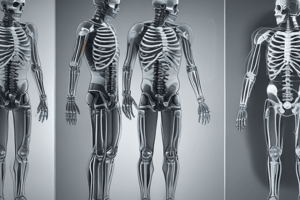Podcast
Questions and Answers
Why is the x-ray tube evacuated?
Why is the x-ray tube evacuated?
- To allow for smoother movement of the electrons
- To prevent collisions of electrons with gas molecules (correct)
- To enhance the brightness of the x-ray images
- To ensure the durability of the x-ray tube
What is one consequence of not evacuating the x-ray tube?
What is one consequence of not evacuating the x-ray tube?
- Increased speed of the electrons
- Increased efficiency of electron conduction
- Reduced risk of filament burnout
- Oxidation or burnout of the filament (correct)
What protects the electrons in the x-ray tube from reducing their speed?
What protects the electrons in the x-ray tube from reducing their speed?
- The design of the x-ray tube
- A coating on the filament
- The vacuum environment of the tube (correct)
- The presence of gas molecules
What is NOT a function of the vacuum in the x-ray tube?
What is NOT a function of the vacuum in the x-ray tube?
What happens to the electrons in the x-ray tube without a vacuum?
What happens to the electrons in the x-ray tube without a vacuum?
What is one of the primary effects that results from the interaction of x-rays with atoms?
What is one of the primary effects that results from the interaction of x-rays with atoms?
What happens to the energy of a photon when it interacts with a tissue atom?
What happens to the energy of a photon when it interacts with a tissue atom?
What is a consequence of the scattering of x-rays during an interaction?
What is a consequence of the scattering of x-rays during an interaction?
Which particle is ejected during the ionization process initiated by x-ray interaction?
Which particle is ejected during the ionization process initiated by x-ray interaction?
What further interaction does the ejected electron undergo after being released from the atom?
What further interaction does the ejected electron undergo after being released from the atom?
What initiates the photoelectric effect?
What initiates the photoelectric effect?
What happens to the energy of the X-ray photon during the photoelectric effect?
What happens to the energy of the X-ray photon during the photoelectric effect?
Which shell electron is typically involved in the photoelectric effect when X-ray photons interact with tissue atoms?
Which shell electron is typically involved in the photoelectric effect when X-ray photons interact with tissue atoms?
Which statement best describes the process of the photoelectric effect?
Which statement best describes the process of the photoelectric effect?
What type of photon predominantly contributes to the photoelectric effect in tissue?
What type of photon predominantly contributes to the photoelectric effect in tissue?
Which type of collimator consists of a metal plate or disk with a hole that allows the beam to pass through?
Which type of collimator consists of a metal plate or disk with a hole that allows the beam to pass through?
What shapes can diaphragms have?
What shapes can diaphragms have?
Which of the following is NOT a type of collimator mentioned?
Which of the following is NOT a type of collimator mentioned?
Which of these collimator types allows a beam to pass through in a controlled manner?
Which of these collimator types allows a beam to pass through in a controlled manner?
Which type of collimator would you use to create a diverging beam?
Which type of collimator would you use to create a diverging beam?
What determines the shape of the X-ray beam?
What determines the shape of the X-ray beam?
Where is the diaphragm placed in X-ray equipment?
Where is the diaphragm placed in X-ray equipment?
Which statement is TRUE regarding the function of the diaphragm in an X-ray machine?
Which statement is TRUE regarding the function of the diaphragm in an X-ray machine?
What is the relationship between the diaphragm and the X-ray beam?
What is the relationship between the diaphragm and the X-ray beam?
What is the primary design consideration for the diaphragm in an X-ray machine?
What is the primary design consideration for the diaphragm in an X-ray machine?
Flashcards are hidden until you start studying
Study Notes
X-ray Tube Vacuum
- Evacuating the x-ray tube prevents collisions between fast-moving electrons and gas molecules.
- These collisions would significantly slow down the electrons.
- The vacuum also prevents oxidation and “burnout” of the filament.
X-ray Photon Interactions with Matter
- X-ray photons can interact with tissue atoms in various ways.
- Compton scattering: X-ray photon ejects a Compton recoil electron.
- Photon energy decreases due to energy transferred to the electron.
- X-ray direction changes, resulting in scattered radiation.
- Photoelectric effect: X-ray photon interacts with an inner-shell electron of the tissue atom.
- Photon is absorbed completely by the electron, resulting in pure absorption.
X-ray Beam Collimation
- Collimation shapes and restricts the x-ray beam.
- Diaphragms are common collimators, consisting of a lead plate with a hole in the center.
- The shape of the diaphragm hole determines the shape of the x-ray beam.
- Diaphragms are placed over the opening of the x-ray machine head.
Studying That Suits You
Use AI to generate personalized quizzes and flashcards to suit your learning preferences.




